DFI UT P35-T2R: Tweakers Rejoice!
by Rajinder Gill on October 18, 2007 2:00 PM EST- Posted in
- Motherboards
Taking a Look at the BIOS, continued
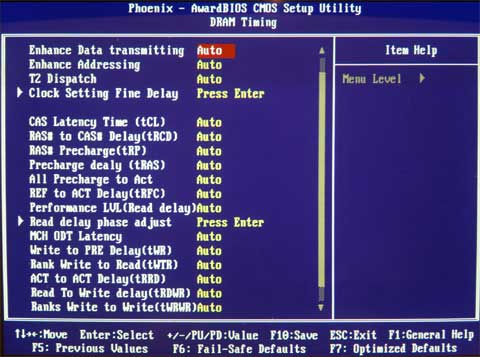
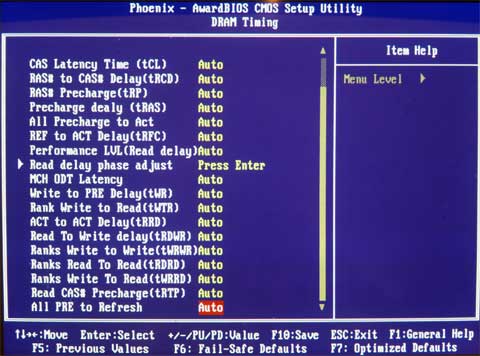
Regardless of individual memory timing preferences, to obtain best RAM/chipset latency performance we recommend that the following BIOS functions are set as follows for Micron D9 based RAM modules.
Enhance Data transmitting: FAST
FAST MODE: Gives latency and bandwidth improvements over the "Normal" setting without overly affecting memory stability or FSB overclocking potential throughout the frequency ranges of interest for everyday use.
TURBO MODE: Is more suited to benchmarking runs. This is a very aggressive setting, further improving latencies past "Fast" mode. Using "Turbo" mode may require that the "CH1CH2 Common CLK Crossing Setting" is set to "Nominal" rather than "More Aggressive". VNB requirements are 1.7V and upwards, hence this should be used strictly for short-term benchmarking.
Enhance Addressing: FAST
This brings additional gains of latency and bandwidth used in combination with the above settings for best overall system performance. Again the stability/voltage requirement hit is only minor for normal PC use.
The difference of using FAST for these two settings together, over NORMAL mode, can be seen clearly in the following synthetic Everest Cache and Memory benchmark screenshots:
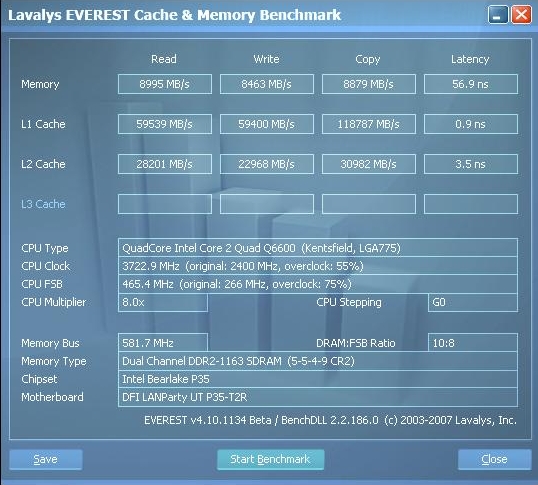

Although the BIOS defaults to Normal mode for both settings, there is no reason to veer away from setting FAST for both functions, provided you're using reasonable memory.
T2 Dispatch: Set this to Disabled, as it gives more overall stability when memory is clocked to high speeds.
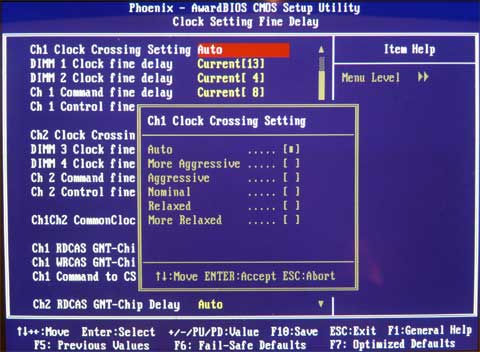
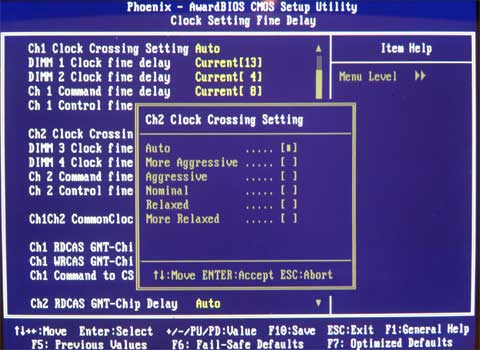
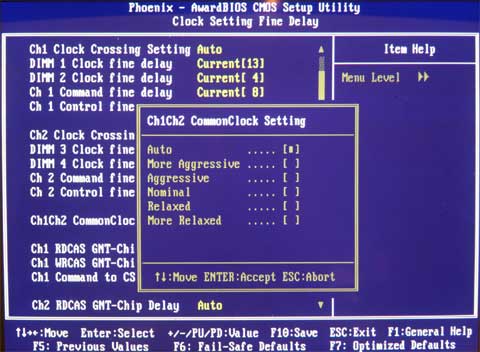
Channel 1 CLK Crossing Setting: More Aggressive
Channel 2 CLK Crossing Setting: More Aggressive
CH1CH2 Common CLK Crossing Setting: More Aggressive
24/7 systems using Micron D9GMH based modules will certainly want to take advantage of using all three of these settings in unison for a latency and bandwidth boost. We have found these three functions set to "More Aggressive" do not hinder the boards FSB progress up to 470FSB for absolute stability. Other RAM modules may not fare as well, unfortunately.
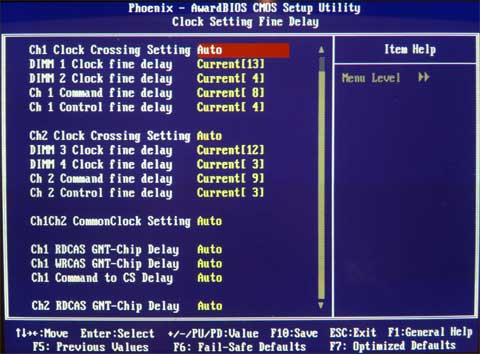
Clock Fine delays: For Both Channels, the 913 BIOS senses and adjusts these values automatically when set to CURRENT mode. DFI has notified users that manual setting ranges should not exceed a margin of three digits either side of the CURRENT setting auto sense. There is some variance at higher FSB levels (over 465FSB on quad-cores). The settings correspond to the DRAM slots in use (the slots filled with RAM are the point of interest). It is worth noting stable ranges on paper and checking back when raising FSB levels to see how the CURRENT setting reacts to FSB changes. If instability is experienced at random between reboots, it may be worth reverting to earlier ranges by setting the scales manually from your notes.


Regardless of individual memory timing preferences, to obtain best RAM/chipset latency performance we recommend that the following BIOS functions are set as follows for Micron D9 based RAM modules.
Enhance Data transmitting: FAST
FAST MODE: Gives latency and bandwidth improvements over the "Normal" setting without overly affecting memory stability or FSB overclocking potential throughout the frequency ranges of interest for everyday use.
TURBO MODE: Is more suited to benchmarking runs. This is a very aggressive setting, further improving latencies past "Fast" mode. Using "Turbo" mode may require that the "CH1CH2 Common CLK Crossing Setting" is set to "Nominal" rather than "More Aggressive". VNB requirements are 1.7V and upwards, hence this should be used strictly for short-term benchmarking.
Enhance Addressing: FAST
This brings additional gains of latency and bandwidth used in combination with the above settings for best overall system performance. Again the stability/voltage requirement hit is only minor for normal PC use.
The difference of using FAST for these two settings together, over NORMAL mode, can be seen clearly in the following synthetic Everest Cache and Memory benchmark screenshots:


Although the BIOS defaults to Normal mode for both settings, there is no reason to veer away from setting FAST for both functions, provided you're using reasonable memory.
T2 Dispatch: Set this to Disabled, as it gives more overall stability when memory is clocked to high speeds.



Channel 1 CLK Crossing Setting: More Aggressive
Channel 2 CLK Crossing Setting: More Aggressive
CH1CH2 Common CLK Crossing Setting: More Aggressive
24/7 systems using Micron D9GMH based modules will certainly want to take advantage of using all three of these settings in unison for a latency and bandwidth boost. We have found these three functions set to "More Aggressive" do not hinder the boards FSB progress up to 470FSB for absolute stability. Other RAM modules may not fare as well, unfortunately.

Clock Fine delays: For Both Channels, the 913 BIOS senses and adjusts these values automatically when set to CURRENT mode. DFI has notified users that manual setting ranges should not exceed a margin of three digits either side of the CURRENT setting auto sense. There is some variance at higher FSB levels (over 465FSB on quad-cores). The settings correspond to the DRAM slots in use (the slots filled with RAM are the point of interest). It is worth noting stable ranges on paper and checking back when raising FSB levels to see how the CURRENT setting reacts to FSB changes. If instability is experienced at random between reboots, it may be worth reverting to earlier ranges by setting the scales manually from your notes.










30 Comments
View All Comments
Acanthus - Thursday, October 18, 2007 - link
Although all of the tweaking options provided are nice, it literally does no better than Asus P5K Deluxe or the Gigabyte P35-DQ6.Furthermore with X38 boards on the way, im not seeing a whole lot of incentive for this $300 motherboard.
Just my $.02
retrospooty - Thursday, October 18, 2007 - link
This board has hit 672mhz FSB, far FAR higher than any other other board ever, including early samples of X38. Not likely to be matched until the DFI X38 comes out.http://www.xtremesystems.org/forums/showthread.php...">http://www.xtremesystems.org/forums/showthread.php...
This link shows it at 666mhz, I cant find the 672mhz one at the moment, but its on the same forum, by the same guy with the same golden CPU.
cmdrdredd - Thursday, October 18, 2007 - link
Not usable 24/7WHO CARES!?
retrospooty - Thursday, October 18, 2007 - link
Well, it still goes alot higher than the others you mentioned, it is absolutely the best overclocking motherboard available. - that was what I responded too, obviously its not the one for you.Acanthus - Thursday, October 18, 2007 - link
That is from the DFI labs... with a beta board... on supercooling...and volt mods... on a dual core CPU that doesnt stress the PWMs...Anandtechs results even using phase dont approach those results.
retrospooty - Friday, October 19, 2007 - link
No, that is not from DFI labs, that is an independant dood, and CPU's that hit that high FSB are pretty rare.Whatever man, you can poo poo it all you want. It is the best OC mobo out there, and goes higher and takes it farther than any other. It may not be the one for you though.
Raja Gill - Thursday, October 18, 2007 - link
You need to remember that this board was compared at stock settings, not OC'ed, things change up top...;), not to mention we could not get the board to crash..regards
Raja
Acanthus - Thursday, October 18, 2007 - link
Its the same chipset, its not going magically increase in a non-linear fashion.The P5K and DQ6 hit the same maximum overclock.
MadBoris - Thursday, October 18, 2007 - link
It makes sense that article takes a different approach, customers of this board or tweakers in general, will really appreciate the fine details.Personally, in the last ten years I have gotten to a place where I am very comfortable not pushing for the last 100 - 300 mhz. The meager tangible return is not worth all the extra voltage or potential stability issues that often come up later in the life of the HW due to creep, dust, aging paste, etc. I get a nice stress test capable OC, then back it up a notch. I won't win any 3dmark awards that way though but am very satisfied with stability when a new product stresses HW in ways not stressed before.
One thing for sure with this board, I wouldn't want to lose the CMOS, then have to remember all my settings after a year.
Nice board and good article, $300 is too much though for a MB for me. It's definitely elite.
retrospooty - Thursday, October 18, 2007 - link
Its alot of reading, but that is because the DFI is alot of motherboard. I have had it since it was first released and loving every minute of it. I have a C2D 6750 running at 8x500 fsb for a sweet 4 ghz on water at DDR2 1000 4-4-4-10 timing, man is it sweet.There are sooooo many bios tweaks to get better performance, or stability at high overclock - its definitely not for beginners... worth every penny of the $300 I spent.